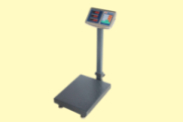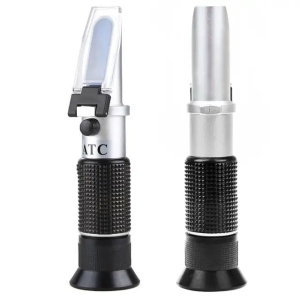Description
Portable Auto Refractometer for Milk: Revolutionizing Dairy Testing
A portable auto refractometer for milk is a must-have tool for farmers, dairy processors, and quality control professionals. This device provides fast, accurate, and reliable measurements of milk composition, including fat, protein, lactose, and total solids. At Eagle Weighing Systems, we bring you cutting-edge refractometers tailored to meet the unique needs of the dairy industry in Uganda.
What is a Portable Auto Refractometer for Milk?
A portable auto refractometer is an advanced instrument that measures the refractive index of milk to determine its composition. It automates readings, making the process quicker and more precise than manual or traditional methods. Its portable design ensures easy on-site use, whether in a dairy farm, processing plant, or laboratory.
Why Choose a Portable Auto Refractometer for Milk?
- Fast and Accurate: Delivers precise measurements in seconds.
- Compact and Portable: Ideal for on-the-go testing in diverse settings.
- Automated Functionality: Eliminates human error with digital readings.
- Wide Measurement Range: Suitable for milk from various sources, including cows, goats, and sheep.
- User-Friendly Design: Simple operation with minimal training required.
Features of Portable Auto Refractometers from Eagle Weighing Systems
At Eagle Weighing Systems, our portable auto refractometers for milk are designed with industry-leading features:
- High-Precision Sensors: Ensures consistent and reliable results.
- Digital Display: Easy-to-read screens show results clearly.
- Automatic Temperature Compensation: Maintains accuracy in varying conditions.
- Battery-Powered Operation: Allows for long-lasting, portable use.
- Durable Construction: Built to withstand regular use in challenging environments.
Applications of a Portable Auto Refractometer for Milk
- Dairy Farms: Analyze milk composition directly at the source.
- Milk Collection Centers: Ensure quality and detect adulteration during procurement.
- Processing Plants: Maintain consistency in large-scale dairy production.
- Quality Assurance Laboratories: Conduct detailed milk analysis for compliance and standards.
- Research and Education: Support studies in dairy science and nutrition.
Frequently Asked Questions
1. How does a portable auto refractometer work?
It measures how light refracts (bends) when passing through a milk sample. The refractive index is used to calculate the concentration of solids such as fat, protein, and lactose.
2. Can it detect milk adulteration?
Yes, it can identify inconsistencies like water dilution, added sugars, or other adulterants by analyzing variations in the milk’s composition.
3. Is it suitable for testing plant-based milk?
Yes, most refractometers can measure plant-based milk like soy, almond, or oat, provided it falls within the device’s measurement range.
4. How do I calibrate the refractometer?
Calibration is simple and typically requires distilled water or a standard calibration solution. Follow the device’s manual for specific instructions.
5. What is the benefit of automatic temperature compensation?
It ensures that readings remain accurate even if the milk or environment temperature varies, reducing the need for manual adjustments.
Prices in Uganda
At Eagle Weighing Systems, we offer competitive pricing for portable auto refractometers:
- Basic Models: UGX 800,000 – UGX 1,200,000
- Advanced Models with Extended Features: UGX 1,500,000 – UGX 2,500,000
Prices depend on features like measurement range, display type, and durability. Contact us for detailed pricing and bulk discounts.
Why Buy From Eagle Weighing Systems?
When you choose Eagle Weighing Systems, you’re investing in quality and reliability. Here’s why customers trust us:
- Premium Quality: All refractometers are rigorously tested for accuracy and performance.
- Affordable Prices: Get industry-leading tools without breaking the bank.
- Expert Support: We provide training, maintenance, and troubleshooting assistance.
- Variety of Options: From basic to advanced models, we have something for everyone.
- Convenient Locations: Visit our stores in Kampala and other major towns.
Related Keywords
Searching for a portable auto refractometer for milk? Explore related terms:
- Digital milk analyzer Uganda
- Dairy refractometer
- Portable milk testing equipment
- Automatic refractometer for dairy
- Milk quality control tools
How to Purchase
Purchasing a portable auto refractometer in Uganda is simple with Eagle Weighing Systems:
- Phone: +256-700225423
- Email: [email protected]
- Visit Us: Check out our stores in Kampala and other regional outlets.
Elevate Your Dairy Operations
A portable auto refractometer for milk is an indispensable tool for anyone involved in the dairy industry. Its precision, portability, and ease of use make it a valuable investment for ensuring milk quality and optimizing production processes.
Choose Eagle Weighing Systems, Uganda’s trusted name in weighing and measurement solutions, to equip yourself with the best tools for dairy testing.












Reviews
There are no reviews yet.